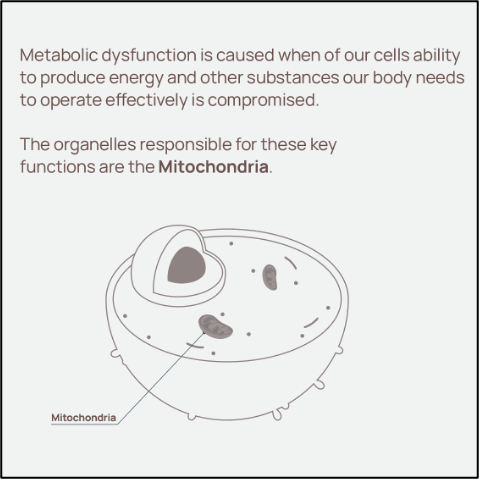Metabolism & Mental Health Part 1
Highlights
- Our current understanding of mental disorders is very limited as we have no widely accepted biological measurements for diagnosing them, whereas our treatment focuses on mitigating symptoms.
- Metabolism holds great promise for providing a universal model for explaining the occurrence and progression of mental disorders.
- The metabolic-based model for mental health opens up the possibility for diet and exercise being powerful cures against the mental health epidemic.
Introduction
Mental health is considered by many medical experts the most dire epidemic of today's society. Its distractive nature is rooted in both the psychological impairment it causes and the physiological co-morbidities it triggers. Nearly every debilitating physiological chronic disease, including metabolic, cardiovascular, and neurodegenerative disease, strongly correlates with mental health disorders. Despite its prevalence, mental health is arguably the least well-understood condition, making consensus around its diagnosis and treatment challenging. A decades-old theory correlating metabolism and mental health disorders has recently come to light, acquiring renewed attention and holding the promise of deterministic diagnosis and treatment. In this three-article series, we explore the link between mental health disorders and metabolism, review the shortcomings of our current understanding of mental health, and discuss the potentially transformative role diet and exercise may have.
Syndrome or Condition? A Difference That Reveals our Limited Understanding of Mental Health
Despite its prevalence and exploding propagation, mental disorders are poorly understood. Modern medicine's poor understanding of mental disorders is reflected in the fact that they are diagnosed and treated as syndromes, not as conditions. The difference between the two is critical, so let's understand it.
In medicine, a condition refers to any health problem or abnormality that can be identified and diagnosed through specific biomarkers, also known as signs (e.g., VO2 max below a certain threshold or fasting blood glucose above a particular level). For example, diabetes is when fasting blood glucose remains elevated above 120 mg/dL. On the other hand, a syndrome is described as a set of symptoms that often occur together and suggest a specific underlying cause or disease but do not have a particular set of biomarkers or observations that will deterministically define its presence. A specific medical condition, genetic mutation, or environmental exposure can cause a syndrome.
In psychiatry, mental disorders are typically diagnosed and treated as syndromes based on the presence of a specific collection of symptoms, not signs. A sign is an objective indicator of an illness that someone else can observe or measure, such as a seizure, a blood pressure measurement, a laboratory value, or an abnormality seen on a brain scan. On the other hand, a symptom is a subjective experience that a patient must report, such as moods, thoughts, experiences of pain or numbness, or sleep disturbances. In psychiatry, most diagnoses are based on symptoms rather than signs. Most mental disorders are diagnosed based on a cluster of symptoms commonly occurring together, referred to as a syndrome. There are currently no laboratory tests, brain scans, or other objective measures that can accurately diagnose any mental disorder.
Our single-faceted focus on symptoms and lack of understanding of the underlying pathology of mental health is also highlighted in how we approach pharmacological treatment for mental disorders. Most common psychiatric disorders, such as depression, major depression, anxiety, and bipolar disorder, are usually treated with the same class of medication. Ultimately, the above highlights the fact that our approach towards psychiatric disorders focuses exclusively on symptoms and implies our ignorance of their actual cause.
Metabolism and Mental Health
Metabolism may offer a way out of our lack of understanding of the underlying pathology of mental disorders. The proposed mechanism linking metabolism and mental health is complex and interconnected but can be boiled down to the fact that mental disorders are metabolic disorders of the brain. Metabolic problems, which can stem from factors such as diet, exercise, sleep, stress, and genetic predisposition, can directly affect neurotransmitter and hormone levels, oxidative stress, inflammation, and immune system function in the brain. This can lead to various mental health conditions such as anxiety, depression, bipolar disorder, schizophrenia, etc. To treat these conditions, interventions that target metabolisms, such as diet and lifestyle changes, medications, and therapy, can effectively restore balance to the brain's metabolic processes.
To understand, however, what metabolic disorders are and their link with brain dysfunctions, we must first understand the fundamental organelle playing the most critical role in our metabolic activity, the mitochondria. Mitochondria are organelles found in eukaryotic cells, including in humans. They are often called the "powerhouses" of the cell because they produce energy in the form of adenosine triphosphate (ATP) through oxidative phosphorylation. In addition to producing energy, mitochondria play other vital roles in cell function, including regulating calcium signalling, producing reactive oxygen species (ROS), and serving as the site of specific biosynthetic pathways. Mitochondria also have their DNA (mtDNA) separate from the cell's nuclear DNA and encode genes essential for mitochondrial function.
Mitochondrial dysfunction can lead to various problems in brain function, including decreased energy production, increased oxidative stress, and impaired neurotransmitter signalling. Specific mitochondrial dysfunctions that have been linked to brain disorders include:
- Impaired mitochondrial respiratory function: This can lead to decreased ATP production and impaired energy metabolism, contributing to neurological and psychiatric disorders.
- Mitochondrial DNA mutations: Mutations in mitochondrial DNA can impair mitochondrial function, leading to decreased energy production and oxidative stress.
- Abnormal mitochondrial morphology: Disrupted mitochondrial shape and distribution can impair mitochondrial function and contribute to neurodegenerative diseases.
- Dysregulated mitochondrial quality control: Disruptions in the processes that maintain mitochondrial health, such as mitophagy and autophagy, can contribute to mitochondrial dysfunction and neurological disorders.
Overall, mitochondrial dysfunction is found at the center of metabolic brain dysregulation and can significantly contribute to a range of mental health conditions. Identifying and addressing these dysfunctions through targeted interventions may be essential to improving brain health.

What are the causes of mitochondrial dysfunction in the brain?
Various factors, including genetic mutations, aging, toxic exposures, nutrient deficiencies, hormonal imbalances, oxidative stress, inflammation, and lifestyle factors such as poor diet, lack of exercise, and chronic stress, can cause mitochondrial dysfunction in the brain. As mentioned, mitochondrial dysregulation from external factors such as alcohol, inflammatory signals, neurotransmitters, and hormones can also contribute to brain mitochondrial dysfunction. Moreover, certain medications can cause mitochondrial dysfunction as an adverse effect. These factors can impair the function of the mitochondria, leading to deficits in energy production, increased oxidative stress, and impaired cellular signalling. Over time, this can lead to cellular damage and death, contributing to disease states such as neurodegeneration, metabolic disorders, and mental health conditions. By identifying and addressing the causes of mitochondrial dysfunction, it may be possible to prevent or treat these diseases and improve overall brain health.

Summary
Mental health is arguably the most rampant but misunderstood chronic condition battering modern societies. Understanding the physiological adaptations that lead to mental disorders is the first step towards understanding them and devising effective long-term plans against them. The proposed mechanism linking mental health to mitochondrial health holds great promise not only because it ecumenically explains the complexity of psychiatric disorders but also because it opens up the exciting potential for diet and exercise, the two most potent and accessible drugs known to humanity, as a cure. In the following two articles of this series, we dive into the transformative role diet and exercise can play in overcoming mental health problems.
The work of Chris Palmer, MD has inspired this article. For further information about metabolism and mental health, readers can refer to his book, Brain Energy. New Paragraph
An Ounce of Prevention - Hyperion Health Blog




